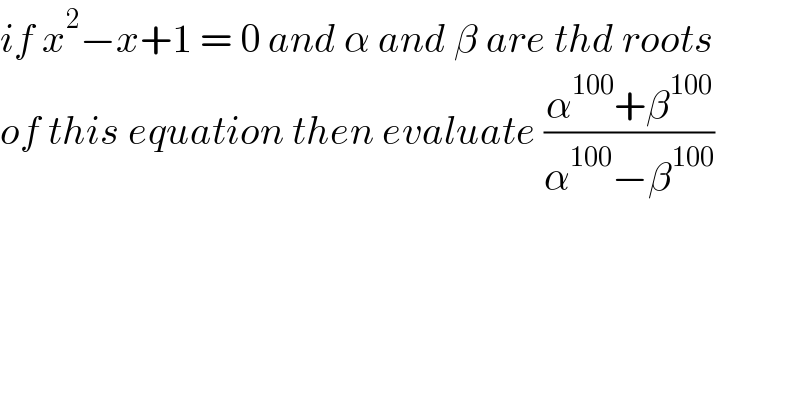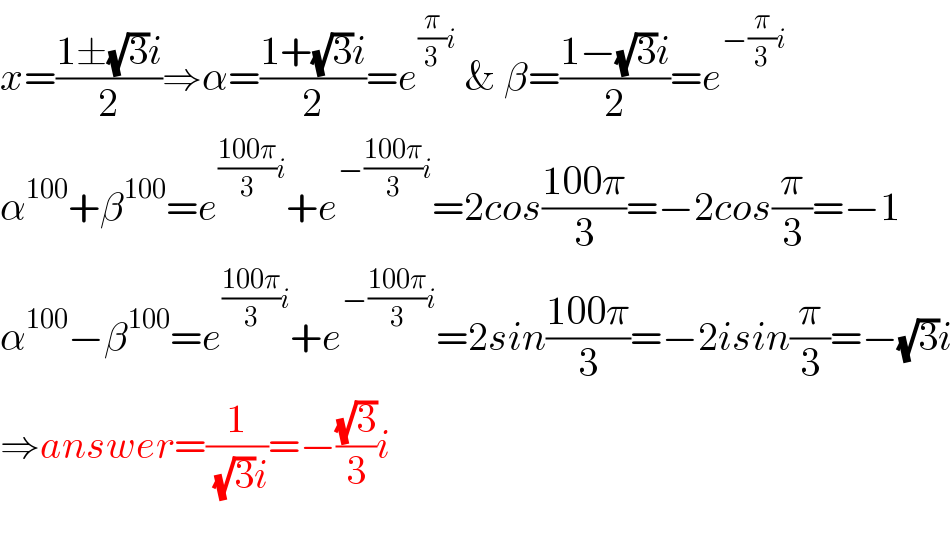
Question Number 191611 by vishal1234 last updated on 27/Apr/23

$${if}\:{x}^{\mathrm{2}} −{x}+\mathrm{1}\:=\:\mathrm{0}\:{and}\:\alpha\:{and}\:\beta\:{are}\:{thd}\:{roots} \\ $$$${of}\:{this}\:{equation}\:{then}\:{evaluate}\:\frac{\alpha^{\mathrm{100}} +\beta^{\mathrm{100}} }{\alpha^{\mathrm{100}} −\beta^{\mathrm{100}} } \\ $$
Answered by mehdee42 last updated on 27/Apr/23

$${x}=\frac{\mathrm{1}\pm\sqrt{\mathrm{3}}{i}}{\mathrm{2}}\Rightarrow\alpha=\frac{\mathrm{1}+\sqrt{\mathrm{3}}{i}}{\mathrm{2}}={e}^{\frac{\pi}{\mathrm{3}}{i}} \:\&\:\beta=\frac{\mathrm{1}−\sqrt{\mathrm{3}}{i}}{\mathrm{2}}={e}^{−\frac{\pi}{\mathrm{3}}{i}} \\ $$$$\alpha^{\mathrm{100}} +\beta^{\mathrm{100}} ={e}^{\frac{\mathrm{100}\pi}{\mathrm{3}}{i}} +{e}^{−\frac{\mathrm{100}\pi}{\mathrm{3}}{i}} =\mathrm{2}{cos}\frac{\mathrm{100}\pi}{\mathrm{3}}=−\mathrm{2}{cos}\frac{\pi}{\mathrm{3}}=−\mathrm{1} \\ $$$$\alpha^{\mathrm{100}} −\beta^{\mathrm{100}} ={e}^{\frac{\mathrm{100}\pi}{\mathrm{3}}{i}} +{e}^{−\frac{\mathrm{100}\pi}{\mathrm{3}}{i}} =\mathrm{2}{sin}\frac{\mathrm{100}\pi}{\mathrm{3}}=−\mathrm{2}{isin}\frac{\pi}{\mathrm{3}}=−\sqrt{\mathrm{3}}{i} \\ $$$$\Rightarrow{answer}=\frac{\mathrm{1}}{\:\sqrt{\mathrm{3}}{i}}=−\frac{\sqrt{\mathrm{3}}}{\mathrm{3}}{i} \\ $$$$ \\ $$
